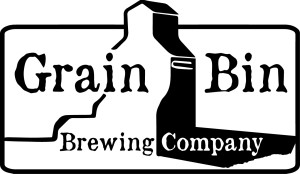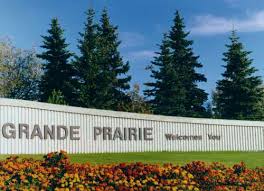 I reported last week about an impending project in Grande Prairie (GP Brewing – which you can read about here), which was the first brewery in that city to being the planning process. As it works out, in what is turning out to be a mini-boom, GP will be the second Grande Prairie brewery to actually produce beer in the northwest Alberta hub.
I reported last week about an impending project in Grande Prairie (GP Brewing – which you can read about here), which was the first brewery in that city to being the planning process. As it works out, in what is turning out to be a mini-boom, GP will be the second Grande Prairie brewery to actually produce beer in the northwest Alberta hub.
Grain Bin Brewing has a very different model than their neighbour – one that has shortened their planning stage and allows them to roll off their first beer sometime in December. The team of six longtime Grande Prairie residents – Dalen Landis, Brad Hanson, Carston Siebert, Danny Hildebrand, Scott Roessler and Arnold Wiebe – are setting out to create something small and nimble to serve the local region.
I recently had a conversation with Landis. He says most of them were basically avid homebrewers with a dream. Landis and some of the partners have been homebrewing together for almost a decade. The idea of going professional has been with them for a while. “We make good beer. People would tell us they would buy our beer, and we would say to ourselves ‘too bad we don’t have million dollars to meet Alberta’s minimum [production requirements]’”, says Landis. “We were not willing to commit that time and money”.
Then a couple years back, the AGLC eliminated the production minimum requirement and suddenly the landscape changed for the team. “That got the creative juices flowing. We can do something small”, Landis remembers. They realized they could do something interesting on a smaller scale. “We said if we are going to do this, we need to set it apart. What can we do small that bigger bigger places can’t?”
The landed on “flexibility”. Their small brewhouse, a three-barrel with three six-barrel fermenters and a bright tank, gives them the opportunity to “create a larger variety of styles” and keep mixing things up. The core of their plan is to provide contract beer to area establishments, providing house beer to pubs. Landis explains it this way: “We sized our equipment to fit the demand of the average bar in town. So we will provide contract services to bars so they can have their own exclusive beer that is designed to cater to their clients”. They hope to design the beer to suit the pub. “We can do tap takeovers and flight nights to gauge what that particular bar would use to pair with their menu and clients, and provide them with their own beer”.
They also see the potential to cater to individuals and organizations for events such as weddings and fundraisers. “If people are having a wedding or party, they can have a small bottle run of a beer designed, bottled, named and labeled for them”. Landis is aware small-batch brewing for weddings is not a big money maker, but sees it more as a way to build connection to the community.
Further to that plan, they also see space for creating collaboration beer with their customers, in what they call their DEMOCRACY! Series. “Every so often we will open it up to the public and brew what they decided for us. This would then be released as a limited bottle run or growler fill”. Landis indicates the mechanism for determining how the style gets chosen is still being worked out.
They have been running a crowdfunding campaign to build some initial interest in the brewery. They also envision other ways to create special offers for funders and others, including a series of small-batch (100 bottles) runs with artistic, hand-painted bottles. “Our goal is to get public involved, to build a sense of ownership in the brewery”, says Landis.
For the moment they have no plans on having their own tap room, although they will do retail sales and growler fills from the brewery. “I know that you make a lot more serving beer by the pint”, says Landis, “but there are a plethora of establishments in town, and we want to work with them, not against them. Our passion is making beer, not serving it, as that comes with so many other aspects”. He points out that Grande Prairie has one of the highest restaurants to population ratios in the country.
 Given their approach, the beer will be varied and shaped by the clients’ needs. However, they do plan to launch with two of their own flagships, a Bitter and a Dunkelweizen. “We have heard some people question if these are the ‘safest’ beers to offer as flagships, but we thought it important to differentiate ourselves, rather than go down the lager/pale/ipa/hefe/stout route”, observes Landis. Besides, he says, many of their clients are likely to want those other styles, so it will give the Grain Bin branding a unique position.
Given their approach, the beer will be varied and shaped by the clients’ needs. However, they do plan to launch with two of their own flagships, a Bitter and a Dunkelweizen. “We have heard some people question if these are the ‘safest’ beers to offer as flagships, but we thought it important to differentiate ourselves, rather than go down the lager/pale/ipa/hefe/stout route”, observes Landis. Besides, he says, many of their clients are likely to want those other styles, so it will give the Grain Bin branding a unique position.
The name references the region’s geography and history. “We are always planning on remaining regionally focussed. All involved are born and raised in surrounding communities around GP”, says Landis. “Grain bins are something we can still see here. They are starting to disappear, but we still ahve some”.
The six partners also bring something tangible to the table. “We wanted people who could bring more than chequebooks”. The team includes a land developer, a homebuilder, a carpetner and an engineer. Landis, formerly a homebuilder and custom tiler, is currently the only one working full-time on the brewery.
Obviously given the size of the brewery, Grain Bin will be available mostly in the Grande Prairie region. So if you want to grab a pint, best you take the drive up Highway 43. But, with any luck, once you arrive you will have no difficulty finding Grain Bin beer on tap in town.

December 3, 2015 at 10:45 PM
“Then a couple years back, the AGLC eliminated the production minimum requirement and suddenly the landscape changed for the team. “That got the creative juices flowing. We can do something small”, Landis remembers. They realized they could do something interesting on a smaller scale.” Just want to point out this change was made prior to the NDP coming to power. The new rate structure and NWP deal did not do this.
December 4, 2015 at 3:24 PM
I think the new rate structure is designed to remove the disincentive to increase production and hit tax barriers that were in the previous legislation. I know from previous discussions with Alberta craft brewers that these were a problem. So far I haven’t heard any complaints from Alberta brewers about the new legislation so I’m not sure why you’re grumbling about it. Could it be you have a political axe to grind?
December 4, 2015 at 10:17 PM
Good point, Barry. I’m glad you brought it up. My comments are as political-neutral as this site. There are two main changes in the new rate structure. Your reply is correct and speaks to the first main change which is to ease the graduations between tax increases for breweries located in AB, SK, BC. I think that is an awesome idea and will *further* encourage Alberta breweries to grow and this is why you haven’t heard any complaints from Alberta brewers. This is the part that has been publicized and what the general public is aware of. However, the second main change is not promoted and so not widely known. Beers produced outside of BC, AB, SK saw the Alberta liquor mark up increase by up to 525%. If the brewery was small and importing beers at the original .20c/L markup, their new markup went up overnight to $1.20/L (a 525% increase). This happened to 40% of the beers listed today. This latter change is unfair, protectionist, and unnecessary given the first main change I described above. Again, to summarize my initial post, Alberta breweries were already opening up shop at a good rate before the new rate structure was put in place. Those are the original author’s words, not mine. The landscape had already changed.